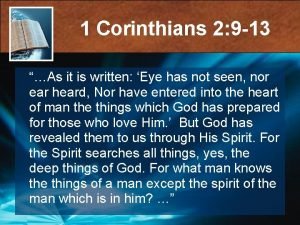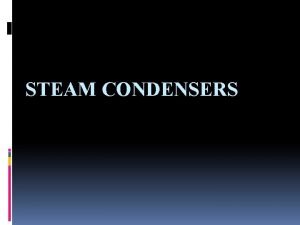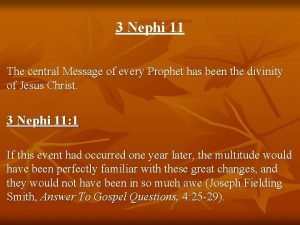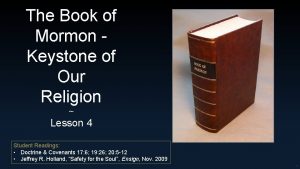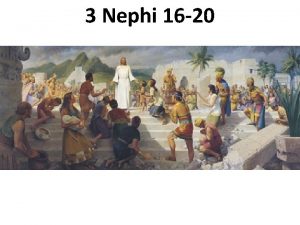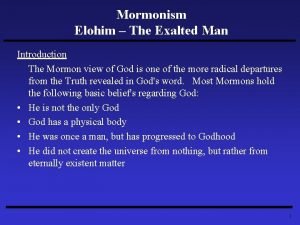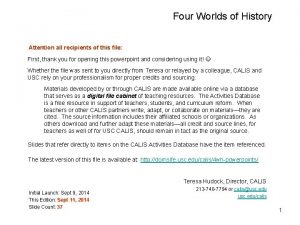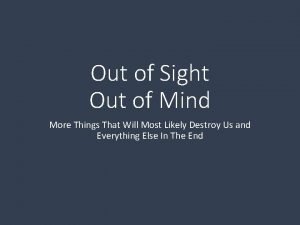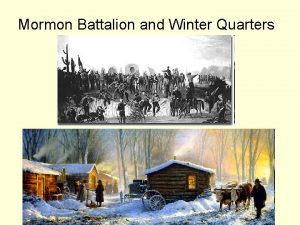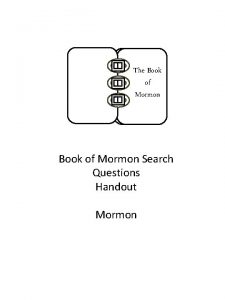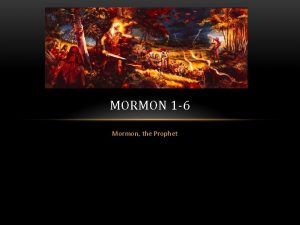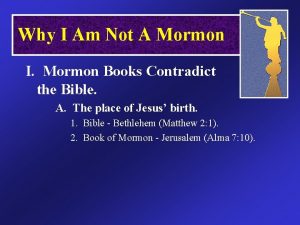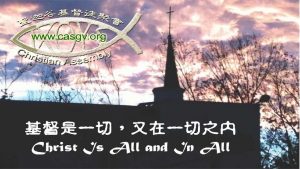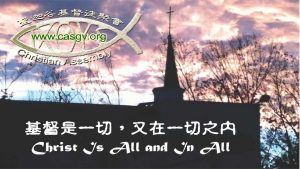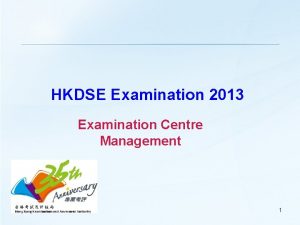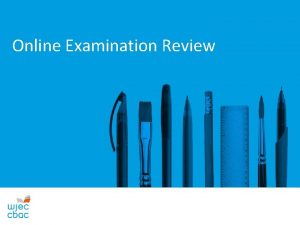COMING OUT MORMON AN EXAMINATION OF SPIRITUAL TRAUMA
















- Slides: 16

COMING OUT MORMON: AN EXAMINATION OF SPIRITUAL TRAUMA AND PTSD AMONG MORMON AND EX-MORMON LGBTQQA ADULTS BRIAN W SIMMONS, MSW, PHD THE UNIVERSITY OF GEORGIA

THE PARADOX OF RELIGION Religion can be a “therapeutic community, ” but can also instill “an abnormal degree of terror. ” 1 Allport & Ross’ religious orientation framework attempted to explain religion’s paradoxical position in producing both benefit and harm. Intrinsic When religion instills terror, it can cause Extrinsic spiritual trauma. Intentional or unintentional harm resulting from religious messages, beliefs, and experiences. © BRIAN W SIMMONS, PHD (2019)

HOW MIGHT RELIGIOUS THEOLOGY AFFECT PTSD? Religious Orientation © BRIAN W SIMMONS, PHD (2019) Spiritual Trauma PTSD

LGBTQQA & LATTER-DAY SAINT THEOLOGY Heterosexual marriage is required for salvation (Doctrine and Covenants 131: 1 -4) Same-sex marriage and cohabitation are considered “a serious transgression. ” 2 Gender is seen as a fixed, eternal characteristic, with “no mismatching of bodies and spirits. ” 7 Overall, LGBTQQA participation in organized religion has been associated with: 10, 11 shame, depression suicidal ideation, difficulty accepting one’s sexual identity, and forfeiture of religious beliefs and community. © BRIAN W SIMMONS, PHD (2019) 3, 4, 5, 6, 8, 9,

STUDY METHODS Web-based, confidential survey Convenience sample recruited primarily via 12 LDS-affiliated LGBTQQA Facebook groups 17 weeks (Oct 2016 - Jan 2017) 278 completed surveys © BRIAN W SIMMONS, PHD (2019)

PARTICIPANT DEMOGRAPHICS 45 % 39 % 16 % © BRIAN W SIMMONS, PHD (2019) 89% 48% 33 white live in Utah Average years old Bisexual 24% Lesbian/Gay 53% SSA 10% Other 13%

LDS CHURCH INVOLVEMENT Temple Endowment Conversion 14% Missionary Service Yes 69% Born in Church 86% Average Age at Conversion: 18 Yes 76% Males Current Temple Recommend: 31% Currently Attend Current Membership Status Good Standing 66% Resign/Excommunication 17% 11% Other Discipline © BRIAN W SIMMONS, PHD (2019) Yes 22% No 24% No 31% 5% No 47 % Yes 52 % No 78% Females

SPIRITUAL TRAUMA Participants ranked 21 religious beliefs and ecclesiastic experiences as: extremely beneficial, neither damaging or beneficial, damaging, extremely I would not be exalted without I would be eternally separated from my family damaging. Homosexuality was a sin. heterosexual marriage. for my same-sex sexual behaviors. God would punish me for my same-sex sexual behaviors. Life-long celibacy was required for me to return to God. I needed to change my sexual or gender identity to be acceptable before God. I would be eternally separated from my family for my sexual attractions. God would punish me for my sexual attractions. A stronger belief in God would change my homosexuality or gender identity. I would be excommunicated for my same-sex sexual behaviors. Associate your gender or sexual identity with an addiction or other temptation. I would be excommunicated for my sexual attractions. My sexual or gender identity would be changed after death. Heterosexual marriage would change my sexual or gender identity. Encourage heterosexual marriage as a solution for your sexual or gender identity. Counsel you to not speak to others about your sexual or gender identity. Encourage you to increase your religious participation to change your sexual or gender identity. Encourage you to seek professional treatment to change your sexual or gender identity. Counsel you to not focus on your sexual or gender identity. Counsel you to not identify as gay, lesbian, bisexual, homosexual, or transgender. Counsel you to separate your sexual attractions from your sexual behaviors. © BRIAN W SIMMONS, PHD (2019)

SPIRITUAL TRAUMA Participants ranked 21 religious beliefs and ecclesiastic experiences as: extremely beneficial, neither damaging or beneficial, damaging, extremely damaging. Homosexuality was a sin. I would not be exalted without heterosexual marriage. I would be eternally separated from my family for my same-sex sexual behaviors. God would punish me for my same-sex sexual behaviors. Life-long celibacy was required for me to return to God. I needed to change my sexual or gender identity to be acceptable before God. I would be eternally separated from my family for my sexual attractions. God would punish me for my sexual attractions. A stronger belief in God would change my homosexuality or gender identity. I would be excommunicated for my same-sex sexual behaviors. Associate your gender or sexual identity with an addiction or other temptation. I would be excommunicated for my sexual attractions. My sexual or gender identity would be changed after death. Heterosexual marriage would change my sexual or gender identity. Encourage heterosexual marriage as a solution for your sexual or gender identity. Counsel you to not speak to others about your sexual or gender identity. Encourage you to increase your religious participation to change your sexual or gender identity. Encourage you to seek professional treatment to change your sexual or gender identity. Counsel you to not focus on your © BRIAN W SIMMONS, PHD (2019) sexual or gender identity. Counsel you to not identify as gay, lesbian, bisexual, homosexual, or transgender. Counsel you to separate your sexual attractions from your sexual behaviors.

SPIRITUAL TRAUMA 95% or participants reported at least one “damaging” or “extremely damaging” spiritual event On average, participants identified 14 damaging events /beliefs 2 -9 Events 17. 3% 10 -14 Events 20. 5% 15 -20 Events 21 Events © BRIAN W SIMMONS, PHD (2019) 47. 5% 9. 0%

PTSD Posttraumatic Stress Disorder (PTSD) is the development of characteristic symptoms following exposure to an extreme traumatic stressor. Intrusion: intrusive thoughts, distressful reminders, flashbacks Avoidance: avoid people/places/thoughts/feelings, diminished interest in life, feeling detached Arousal: easily startled, hypervigilance, difficulty concentrating, irritability Participants were asked about PTSD symptoms related to religious or spiritual experiences. On average, participants experienced: 3 intrusion symptoms 5 avoidance 4 arousal symptoms Overall, 73% of participants would have likely met PTSD diagnostic criteria © BRIAN W SIMMONS, PHD (2019)

PTSD PREVALENCE nearly ten times Study respondents were more likely to experience PTSD than the general adult population (8%) 8% All Respondents 73% Not Attending Currently Attending © BRIAN W SIMMONS, PHD (2019) 84% 65%

STUDY FINDINGS Spiritual trauma was significantly correlated with PTSD. As spiritual trauma increased, so did PTSD symptoms. Spiritual trauma was NOT correlated with religious orientation. All religious orientations endorsed a high level of spiritual trauma. © BRIAN W SIMMONS, PHD (2019)

WHAT WE’VE LEARNED: Religious teachings and experiences are capable of producing trauma responses. Increased exposure to harmful messages increases trauma responses. LGBTQQA Mormons are nearly ten times more likely to meet PTSD diagnosis (73%) was than the general US adult population (8%) © BRIAN W SIMMONS, PHD (2019)

WHAT CAN BE DONE? Riddle Scale Nurturance Appreciation Admiration Support Acceptance Tolerance Positive Attitudes Negative Attitudes Pity Repulsion © BRIAN W SIMMONS, PHD (2019) (Riddle, D. I. , 1985)

REFERENCES 1 Allport, G. W. (1963). Behavioral science, religion, and mental health. Journal of Religion and Health, 2(3), p. 187 -197. 2 Church Newsroom (2019, April 04). First Presidency shares messages from General Conference Leadership Session. Retrieved from https: //newsroom. churchofjesuschrist. org/article/first-presidency-messages-general-conference-leadership-session-april-2019. 3 Dahl, A. L. & Galliher, R. (2009). LGBTQQ young adult experiences of religious and sexual identity integration. Journal of LGBT Issues in Counseling, 3, 92 -112. 4 Gage Davidson, M. (2000). Religion and spirituality. In R. M. Perez, K. A. De. Bord, & K. J. Bieschke (Eds. ), Handbook of counseling and psychotherapy with lesbian, gay, and bisexual clients (pp. 409– 433). Washington, DC: American Psychological Association. 5 Lease, S. H. , Horne, S. G. , & Noffsinger-Frazier, N. (2005). Affirming faith experiences and psychological health for Caucasian lesbian, gay, and bisexual individuals. Journal of Counseling Psychology, 52(3), 378 -388. 6 Mahaffy, K. A. (1996). Cognitive dissonance and its resolution: A study of lesbian Christians. Journal for the Scientific Study of Religion, 35, 392– 402. 7 Packer, B. K. (1976). To young men only. Salt Lake City, UT: Intellectual Reserve, Inc. 8 Rodriguez, E. M. , & Ouellette, S. C. (2000). Gay and lesbian Christians: Homosexual and religious identity integration in the members and participants of a gay-positive church. Journal for the Scientific Study of Religion, 39, 333– 347. 9 Ryan, C. & Rees, R. A. (2012). Supportive families, healthy children: Helping Latter-day Saint families with lesbian, gay, bisexual & transgender children. San Francisco, CA: Family Acceptance Project, Marian Wright Edelman Institute, San Francisco State University. 10 Schuck, K. D. , & Liddle, B. J. (2001). Religious conflicts experienced by lesbian, gay and bisexual individuals. Journal of Gay & Lesbian Psychotherapy, 5, 63– 82. 11 Sherkat, D. E. (2002). Sexuality and religious commitment in the United States: An empirical examination. Journal for the Scientific Study of Religion, 41, 313 -323. © BRIAN W SIMMONS, PHD (2019)
 1 corinthians 2:9-13
1 corinthians 2:9-13 Shot me out of the sky one direction
Shot me out of the sky one direction Coming out to parents letter
Coming out to parents letter In shell and tube surface condenser
In shell and tube surface condenser 3 nephi 11 explained
3 nephi 11 explained Book of mormon keystone of our religion
Book of mormon keystone of our religion Mormon and freemason forgeries
Mormon and freemason forgeries Mormon and freemason forgeries
Mormon and freemason forgeries The book of mormon another testament of jesus christ
The book of mormon another testament of jesus christ Subculture in consumer behaviour
Subculture in consumer behaviour Mormon and freemason forgeries
Mormon and freemason forgeries Lds jeopardy questions
Lds jeopardy questions Book of mormon stories that my teacher tells to me
Book of mormon stories that my teacher tells to me Elohim mormon
Elohim mormon The four worlds of history
The four worlds of history Out, damned spot! out, i say!
Out, damned spot! out, i say! Outta sight outta mind quotes
Outta sight outta mind quotes
